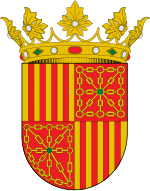Duke of Aliaga
This article includes a list of general references, but it lacks sufficient corresponding inline citations. (July 2014) |
You can help expand this article with text translated from the corresponding article in Spanish. (September 2012) Click [show] for important translation instructions.
|
| Dukedom of Aliaga | |
|---|---|
 | |
| Creation date | 10 October 1487 |
| Created by | Ferdinand II |
| Peerage | Peerage of Spain |
| First holder | Juan Fernandez de Híjar y Cabrera, 1st Duke of Híjar |
| Present holder | Luis Martínez de Irujo y Hohenlohe-Langenburg, 19th Duke of Aliaga[1] |
Duke of Aliaga (Spanish: Duque de Aliaga) is a hereditary title in the Peerage of Spain, accompanied by the dignity of Grandee and granted in 1487 by Ferdinand II to Juan Fernández de Híjar, Count of Aliaga, Duke of Híjar and later also Duke of Lécera.[2][3]
It is one of the highest titles of Spanish nobility associated with one of the members of the Grandes de España. The title was created in 1487 by King Ferdinand II of Aragón (el Catolico)[4] who raised the County of Aliaga to the status of a Dukedom. The title was created as a favor to Juan Fernández de Híjar y Cabrera who had been previously appointed as Count of Aliaga on 31 December 1461 by Ferdinand's father, John II of Aragon.[5]
Aliaga is a municipality in the Province of Teruel, Aragon.
The title of Count of Aliaga, along with a title of lordship over Castellote, was granted to Juan Fernández by John II as a compensation and restitution bonus after peace was made in a war for power between Carlos de Viana, King John II's son and the king. Juan Fernández had fought on the side of the king's illegitimate son.
Juan Fernández de Híjar y Cabrera was the son of Juan Fernández de Híjar, the fifth Baron of Hijar and first lord of Lécera (title which he purchased). His mother was Juan Fernandez' second wife, Timbor de Cabrera, daughter of Bernardo de Cabrera, first Count of Módica, XXIV Viscount of Cabrera, XXVI Viscount of Bas, and II Viscount of Osuna.
The title over the Dukedom of Aliaga has been carried consistently for almost five centuries, having been almost 400 years under the control of the House of Híjar. As such, the Dukedom of Híjar and the Dukedom of Lécera have also traditionally been associated with title over Aliaga. These titles were separated after the reign of 12th Duke, José Rafael de Silva y Fernández de Híjar in 1863 who became the last Híjar to hold the title.

Dukes of Aliaga
| Title | Period | |
|---|---|---|
| Created by Ferdinand II of Aragon | ||
| I | Juan Fernández de Híjar y Cabrera | 1487–1493 |
| II | Luis Fernández de Híjar y Curton | 1493–1517 |
| III | Juan Francisco Fernández de Híjar | 1517–1614 |
| IV | Isabel Margarita Fernández de Híjar y Castro-Pinós | 1620–1642 |
| V | Jaime Francisco Sarmiento de Silva | 1642–1700 |
| VI | Juana Petronila de Silva y Aragón | 1700–1710 |
| VII | Isidro Francisco Fernández de Córdoba y Portugal Silva | 1710–1745 |
| VIII | Joaquín Diego de Silva y Moncada | 1745–1758 |
| IX | Pedro de Alcántara Fernández de Híjar y Abarca de Bolea | 1758–1797 |
| X | Agustín Pedro de Silva y Palafox | 1797–1817 |
| XI | Francisca Javiera de Silva y Fitz-James Stuart | 1817–1818 |
| XII | José Rafael Fernández de Híjar | 1818–1863 |
| XIII | Andrés Avelino de Silva y Fernández de Córdoba | 1863–1885 |
| XIV | Alfonso de Silva y Campbell | 1885-1898 |
| XV | Alfonso de Silva y Fernández de Córdoba | 1898-1954[6] |
| XVI | Alfonso Martínez de Irujo y Fitz-James Stuart | 1954-2015 |
| XVII | Luis Martínez de Irujo y Hohenlohe-Langenburg | 2015-actual title holder |
References
- ^ Boletín Oficial del Estado (BOE) - 31 July 2015
- ^ Real Asociación de Hidalgos de España, Elenco de Grandezas y Títulos Nobiliarios Españoles, Ediciones Hidalguía, Vol. 50 (Madrid, 2018), pp. 61-62
- ^ Search of title "Aliaga, duque de"
- ^ "Aliaga, Ducado de (Teruel.)". archivoducaldehijar-archivoabierto.com (in Spanish). Archivo Ducal de Hijar: Archivo Abierto. Archived from the original on 2011-09-04.
Posteriormente, el Católico, elevó a Ducado el recién creado Condado de Aliaga (Córdoba, 10.X.1487)
- ^ Madoz, Pascual (1830). P. y Sagasti Madoz (Madrid, A.) (ed.). Diccionario Geográfico-Estadístico-Histórico de España y sus Posesiones de Ultramar (in Spanish). Vol. 9. Madrid: Est. Literario-Tipográfico de P. Madoz y L. Sagasti. p. 204. Retrieved 11 August 2014.
- ^ (TIF) BOE Nº 13: Solicitud de 5 de mayo de 1953
Sources
- Instituto Luis de Salazar y Castro (2011). Elenco de Grandezas y Títulos Nobiliarios Españoles (in Spanish). Madrid: Ediciones de la Revista Hidalguía.
